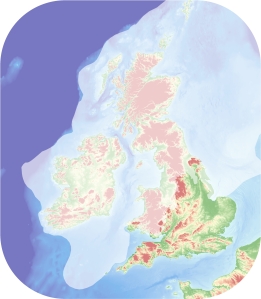By Margot Saher, Dave Roberts and Rich Chiverrell (Photography by Alex Ingle)
Darkness. A great mass of ice overhead. The eerie rumbling of a large, uncompromising mass, slowly but steadily on the move. Below a thick layer of stiff red sediment, ground off the red bedrock, crushed and churned into a lumpy, sticky blanket of glacial till.
What would later be called Cape Wrath was only miles to the south, but there was no cape yet. Just the grinding of slow and unforgiving ice moving north into the North Atlantic. But the times were changing. The sun gained in strength, atmosphere and ocean started to warm and the gigantic ice mass, later to be known as the British-Irish Ice Sheet, was in decline. As its surface melted, more water reached its bed, and it began to slide helplessly over its own sediments. Slowly it thinned, and retreated in the direction of the Scottish mountains with the ocean lapping relentlessly at its edges.
There seemed to be no hope, but the ice sheet made one last bold dash towards the edge of the continental shelf before it faltered. The recently deglaciated seabed and freshly deposited grey ocean sediments were bulldozed and overrun again by ice on the move, and buried once more in a blanket of red till. Linear ridges (moraines) marked the limit of this temporary re-advance. But it was only a death throw; the re-advance didn’t get far. The ice sheet’s days were numbered. The advance stopped, and turned into irreversible retreat.

A geophysical search for the perfect core…….
Against a backdrop of rumbling, calving icebergs, station JC123-048VC slowly became ice free, as the snout of the ice sheet moved back over the site. A cold, shallow sea took its place; first, still close to the snout of the ice sheet, where streams of meltwater rushing into the waiting sea water lay down a blanket of coarse sand. As the ice retreated further, taking the meltwater streams with it, the sea fell silent. Only fine sediments spat out into suspension by the dying ice sheet made it to our site, slowly covering it in a thick, grey blanket.
The ice sheet sent a final message as the ice margins retreated south towards the land; a message from an iceberg. As it passed, melting, overhead of station JC123-048VC, pebbles slipped from its icy grip. They plummeted into the depths, impacting into the soft fine clay sea bed. As soon as this excitement started it was over, and the pebbles were slowly covered by more of the same grey clay.
With the great weight of the ice gone, the Earth’s crust rose like an ancient giant from its slumbers, pushing the Scottish continental shelf closer to the sea surface. Over time, the waters shallowed, and the seabed currents became stronger. The last vestiges of the glacial seafloor were scoured by contour currents, which deposited the spoils of an energetic coast on the eroded sediment below. Millennia later coarse sand and shell debris formed a layer of several inches thick. And then on Sunday the 12th July 2015 all changed.
There was an unfamiliar thud, and then the uncanny sensation of a vibrating tube burrowing into the sediment from above. It cut through the sand in a jiffy, passed the pebbles, and into the soft clays. The tube slid through it like a hot knife through butter. No struggle with the coarse sands lain down by meltwater streams either, only slowing on reaching the stiff, red till. It battled its way into it for a meter and a half. Then the friction became too much. The vibrocorer stopped, and then the whole tube, now full of sediment, was pulled back up to the sea surface, and hoisted back up onto the deck of the RRS James Cook, the ship it had come from. Peace returned once again on to the sea floor, at core site VC123-048VC, a few miles north of Cape Wrath, on the northwestern edge of Scotland; a land mass now devoid of ice sheets and glaciers.
The core came on board and was cut into sections, labelled, scanned, and split. Finally, we, the scientists who had planned the project, planned the cruise, sailed all the way from Southampton to Cape Wrath, and waited for the British Geological Survey (BGS) to deliver the core, first laid eyes on the sediment. The story was there: a stiff basal till deposited beneath the ice sheet; fines marking the first incursion of the sea; further glacial till documenting the ice re-advance, meltwater stream sediments deposited in front of the retreating ice margin; the fine clays deposited when the ice began to recede southwards containing drop-stones from the icebergs, and the marine sand of the modern seafloor. That was what we had come for. And this was the 48th core; none of the previous 47 had told the story of the vanishing British ice quite this clearly.
Hopefully we’ll be getting more cores like this in the coming three weeks of the cruise. We need this story told in every sector of the British-Irish continental shelf. Only then will we have what we set out for: the complete saga of the Last British-Irish Ice Sheet.




